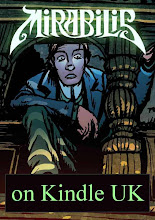Happy Holidays! Here's a few of my hand-drawn Christmas cards :)
-
Happy Holidays, everyone! Thank you for the incredible support this year,
to all the readers of the new magazine, to all the Kickstarter backers
from ba...
Friday, 20 December 2019
How not to script an action climax
Picture this . You’re at a Hollywood pitch meeting: "And as the LEM descends towards the moon, Armstrong has a crisis of confidence. 'I can't do it, Buzz!' he says. But then he has a dream in which he's standing in the Midwest somewhere with a baseball bat, and Chuck Yeager is there dressed as a giant eagle and he's about to pitch the ball. Neil drops the bat, but Chuck tells him to pick it up, he can do it. And as he reaches for the bat we're back on the LEM and he's reaching for the controls. Determined look from Neil, admiring look from Buzz, swelling music, and then we cut to Houston and after a long tense pause: 'The Eagle has landed.'"
That’s terrible writing. Yet it’s the sort of thing that’s all the rage in superhero movies. We’re at the climax and the hero is on the brink of defeat. They go into a dream sequence, get a pep talk from a (usually dead) mentor, then snap back to the present and "with one bound" they’re free and turn the tables on the baddie. Thor: Ragnarok, Captain Marvel, you name it.
To be clear, I'm not complaining about mentors (though they are overused because every screenwriter swears by Joseph Campbell these days), I’m complaining about the interior vision in which the hero is given a boost of wisdom or courage: ‘Here’s your elixir like Campbell talks about on page 497. Now get back and fight.’ It's lazy writing. The dream sequence approach is no different from fixing all the loose ends in a story by dropping a god out of the machinery.
It’s bad writing because it’s telling, not showing. It kills momentum by building to what ought to be a nail-biting moment and suddenly swerving off into a fantasy scene. In effect, rather than crafting the story, the writer is taking a time out to try and convince us why his or her story should work. Those writers are so used to notes and rewrites that they don’t know that’s not how the finished thing should look; it’s as though you arrived at a building and found the only way to the upper storeys was by way of scaffolding left by the builders.
Good writing would be to have already done the work throughout the story so we are able to see the character’s arc leading inevitably to this point. Examples: Iron Man and Captain America: The First Avenger. Or, returning to the building analogy: put the bloody stairs in.
Subscribe to:
Post Comments (Atom)























No comments:
Post a Comment